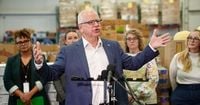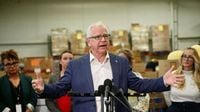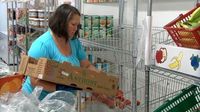As the federal government shutdown stretches into its 27th day, Minnesota finds itself on the front lines of a growing food crisis. With federal funds for food assistance programs running dry, Governor Tim Walz has stepped in, announcing on October 27, 2025, that $4 million in emergency state funding will be immediately distributed to food shelves across Minnesota. The move, which Walz described as a “lifeline,” comes just days before more than 440,000 Minnesotans are expected to lose their Supplemental Nutrition Assistance Program (SNAP) and Minnesota Family Investment Program (MFIP) benefits starting November 1.
“Food shelves provide a refuge for hundreds of thousands of Minnesotans. Yet the Trump Administration has chosen to cut off these critical benefits that keep families from going hungry,” Governor Walz said during a news conference at The Open Door Pantry in Eagan, according to KNSI. “But if Washington won’t lead, Minnesota will. This funding will serve as a lifeline to help Minnesotans weather the storm.”
The urgency is palpable. The U.S. Department of Agriculture has stated it will not cover food assistance costs, despite contingency funds remaining available. Unless Congress reconvenes and passes a spending bill, recipients will not receive their usual EBT card credits for groceries in November. The brunt of this impact will be felt by the most vulnerable: 36% of those relying on SNAP and MFIP are children, and 18% are seniors, according to data from the Minnesota Department of Children, Youth, and Families (DCYF). People with disabilities also make up a significant portion of recipients, as reported by multiple outlets including The Open Door food shelf’s executive director, Jason Viana.
The numbers paint a stark picture. Food shelves in Minnesota recorded nearly 9 million visits in 2024—a staggering increase from 3.8 million in 2021. According to a statewide survey cited by the Minnesota Reformer, about 1 in 5 Minnesota households experienced food insecurity in 2024. The Open Door Pantry in Eagan, for instance, is already serving about 30% more people than last year, helping more than 25,000 individuals each month across Dakota County. “Before the shutdown began, the need had already grown,” Viana said. “We’ve heard increased concern and anxiety from our families, and we’re seeing more families than we have since 2020. This is a time for anyone in our community that cares about our neighbors to take action.”
The $4 million state funding, which comes from the Department of Human Services’ emergency services account and the Family First Prevention Services Act, will be distributed through Minnesota’s existing food shelf network. Each food shelf and Tribal Nation will receive a base amount of $5,000, with additional allocations based on local need. About 300 food shelves and Tribal Nations are expected to benefit from the emergency funds, according to DCYF. The state’s goal is to get the money out by November 4—the same time the next round of grocery benefits would normally be distributed.
Most of the funds will go directly toward purchasing, transporting, and distributing food to those in need, following the Minnesota Food Shelf Program statute. "For many Minnesotans, the $6 a day they receive in SNAP is the difference between going hungry or just getting by," said DCYF Commissioner Tikki Brown, as quoted by WCCO News. “This emergency support is necessary but cannot fill the gap left behind by the loss of SNAP and MFIP benefits. When food support disappears, the consequences for Minnesota are immediate and far-reaching. It impacts public health, the State and local economies, education, and workforce stability.”
Still, officials are clear-eyed about the limitations of the state’s response. “This is meant to be a bridge,” Walz emphasized. “It will not make up and backfill everything that is going to drop off starting on Saturday.” Jason Viana echoed that sentiment, saying, “All the work and care of our community is not enough to solve an absolutely solvable crisis.” He added that the $4 million will “absolutely be enough to help for a small period of time, but it won’t make us whole.”
The funding gap looms large. The federal government’s role in providing food assistance is foundational, and state officials have been vocal in criticizing the lack of urgency in Washington. “It’s Day 27, and there doesn’t appear to be any sense of urgency out of the folks in D.C.,” Walz said, as reported by KVLY. “As this continues to go on, it will become much more of a crisis.” Walz also called on Congress to return to work, but insisted that Democrats should continue to refuse to vote for a budget bill that doesn’t include health care subsidies, “for as long as it takes.”
SNAP and MFIP benefits support residents in all 87 counties and Tribal Nations across Minnesota. The programs are a crucial safety net, and their sudden disruption threatens to push thousands into deeper hardship. For those with unspent funds on their EBT cards, officials have clarified that they can still buy approved food items even after November 1. However, the uncertainty around future benefits has left many families anxious about how they will put food on the table in the coming weeks.
Community organizations are bracing for a surge in demand. The Open Door Pantry, for example, is planning to increase its food distribution to meet the anticipated need. “We’re seeing more families than we have since 2020,” Viana noted, referencing the early days of the COVID-19 pandemic when food insecurity spiked nationwide. Officials are also encouraging anyone who is able to donate to their local food shelf, stressing that every bit helps in a time of crisis.
With no clear end in sight to the shutdown, state leaders are warning that Minnesota’s ability to continue backfilling lost federal funds is limited without reimbursement from Washington. “In the most abundant food supply of any country on Earth, it’s absolutely unnecessary for people to go hungry,” Walz said. The sentiment resonates as food shelves across the state prepare for an influx of families in need, hoping that federal lawmakers will act before the situation worsens.
For now, Minnesota’s emergency funding provides a temporary lifeline, but the underlying crisis remains unresolved. As November approaches, the state’s food shelves and the communities they serve are left waiting—anxiously watching Washington, and hoping for action before the cupboard runs bare.


